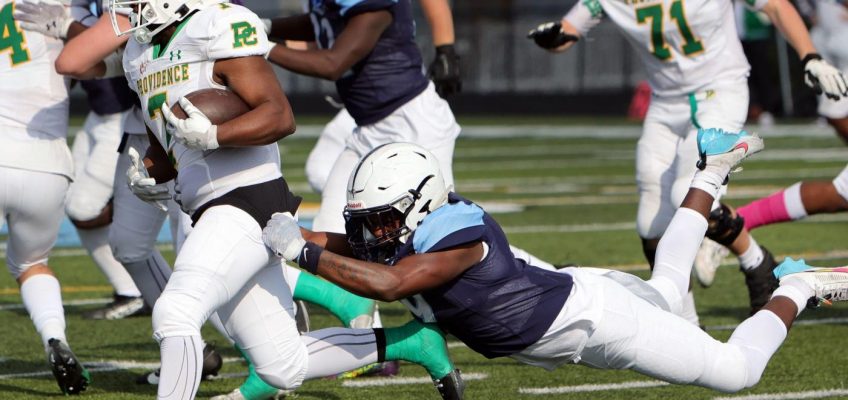For the final eight minutes of the Chicago Bulls’ Wednesday loss to the Phoenix Suns, Alex Caruso drove Kevin Durant into a state of frustration.
The guard acted as a shadow for Durant throughout the night, poking and prodding to keep the forward from settling into a comfortable scoring rhythm down the stretch. Caruso hung all over Durant on his final attempt at a game-winner with time expired, forcing him to take a slightly off-balance shot that clanked off the rim to send the game into overtime.
Durant finished with 25 points, nearly five points below his season average. But Durant scored only four in the final two frames of the game, a testament to Caruso’s nullifying presence.
“It’s his mentality,” Durant said. “He’s a hard worker who’s going to do everything he can. He’s a phenomenal player. I don’t even want to call him a role player, but just a guy that you can plug with any lineup and he’s going to make the right reads, the right plays on the defensive and offensive side. The Bulls are lucky to have him.”
Caruso is typically the defensive savior for the Bulls, swooping in to poke away turnovers and smother top scorers like Durant. But his offense balanced out an all-around performance Wednesday.
In the first quarter, Caruso drained a trio of consecutive 3-pointers to spark a 14-3 run that pulled the Bulls back from an 18-point deficit. And his sharpshooting from deep continued into overtime as he finished 4-for-5 from behind the arc. Caruso even flexed his playmaking abilities in the fourth quarter, faking an inside pass before finger-rolling the ball into the basket.
Caruso’s final scoreline reflected his eclectic impact on the game: 19 points, four rebounds, three steals, two blocked shots.
But Caruso couldn’t will the Bulls to a win. Jusuf Nurkić hit the go-ahead basket with seven seconds left in overtime and the Suns squeaked out of Chicago with a victory.
Here are six other takeaways from the loss:
1. Bulls erased a double-digit deficit in the first half.
It didn’t take long for the Bulls to dig themselves into a hole on Wednesday. The Suns opened the game on a 22-4 run. Within the first six minutes of play, the Bulls fell behind by 18 points after Grayson Allen hit his second 3-pointer of the night.
Despite a flat-footed start, the Bulls woke up toward the end of the first quarter when Caruso took the court. Caruso knocked down three consecutive 3-pointers to spark a 14-3 run, helping the Bulls cut the lead to 36-28 by the end of the first quarter.
The Bulls starters took the game back in the second quarter. Coby White scored nine points including a 3-pointer. DeMar DeRozan drew three shooting fouls to score six points. And Nikola Vučević carved out space in the paint to add eight points.
After trailing for the majority of the half, the Bulls entered halftime with a level score after Vučević hit a hook shot with a second left to tie the game.
2. Turnovers defined results — good and bad.
The Bulls pulled themselves back into the game by capitalizing on mistakes. They forced Phoenix to cough up the ball 21 times and scored 30 points off turnovers for the second game in a row. The entire roster combined for 12 steals, with White and Caruso recording three apiece.
But turnovers were also the final straw for the Bulls in the last stretch of a contentious game. The Bulls turned the ball over twice in the final minute of regulation and two more times in overtime. Those mistakes were too costly against the Suns, leaving enough margin for a one-point loss.
3. Zach LaVine struggled on both ends of the court.
Despite scoring 22 points, LaVine struggled for the Bulls throughout Wednesday’s game. He picked up a defensive 3-second violation in the first quarter and allowed guards to slip by him consistently on backdoor cuts.
LaVine shot 3-for-6 from behind the arc, but he couldn’t clinch shots when it counted. In the final minute of regulation, LaVine missed one chance at a tying shot, then fumbled the ball off his leg with 45 seconds left for a turnover. He did not score in overtime and finished with three total turnovers.
4. 3-point shooting levels out.
After an ice-cold start to the season, the Bulls’ 3-point shooting is beginning to level out.
The team shot 14-for-33 (42.4%) from behind the arc two nights after shooting 52.9% against the Utah Jazz. Torrey Craig went 0-for-2 and White went 1-for-5 from 3-point range, but the rest of the players who took at least one attempt finished above 40% from deep. Caruso led the Bulls with four 3-pointers and LaVine added three.
The Bulls took six 3-point shots in overtime, so their tally of attempts in regulation (27) still fell closer to their average attempts from last season.
5. Bradley Beal returned to the court.
Bradley Beal made his debut for the Suns in Chicago on Wednesday after missing the first seven games of the season with a back injury. He played on a minutes restriction, finishing with 13 points in 23 minutes. Beal played most of his minutes with the secondary unit, which allowed the Bulls to throw traps at the guard to keep the ball out of his hands. He did not play at all in overtime.
Devin Booker did not play for the Suns on Wednesday due to a right calf strain.
6. Grayson Allen lit up the arc.
After run-ins with Caruso and DeRozan over the past two seasons, Allen isn’t well-loved at the United Center. But he also has a pattern of matching boos with made 3-pointers — which he continued on Wednesday.
Allen went 8-for-13 from behind the arc, a career-high in single-game 3-pointers. His team-high 26 points were critical for Phoenix to fend off a Bulls comeback.
()




